The Honourable Society of the Inner Temple. Art collections and Law Library decant, May 2019
Project Overview
Art Collections
The Inner Temple was established in 1312 and has a long history of collecting and acquiring art and furniture collections. It has had a chequered history, however. The Great Fire of London of 1666 destroyed many of the Inner Temple buildings and a series of subsequent fires and 20th century war damage were responsible for further losses. The Hall, Treasury Office, Benchers' Rooms and Library were all reconstructed after World War II, however over 150 paintings were lost during World War II. Fortunately, the Inn still retains a large collection of portraits of its famous, favourite and most successful members. Sitters include monarchs, numerous Lord Chancellors (a full house in fact), Lord Chief Justices and holders of every rank of judicial office, including the first lady High Court Judge, Dame Elizabeth Lane. Of particular interest are the portraits of the four so-called fire judges, Sir John Vaughan, Sir Orlando Bridgman, Sir Thomas Tyrrell and Sir Heneage Finch, which hang in the Hall Gallery. Following the devastation caused by the Great Fire of London in 1666, twenty-two of the chief judges of England were charged by the Court of Alderman of the City of London with resolving the numerous boundary and tenancy disputes which had arisen.

Although many other portraits have come as gifts or bequests, it is clear that commissioning portraits has been a tradition since the seventeenth century. Kneller is just one of many illustrious artists whose works are represented in the Inn; Allan Ramsay George Romney and John Hoppner were the equals in their day to De Lazlo, Sir Oswald Birley, Augustus John, Sir Herbert Gunn and Sir John Lavery in the last century. Today a lighter touch can be brought to the Inn’s commissions. The recent portraits of the five judges by Jane Mendoza, of Lord Irvine by James Lloyd, of Lord Rawlinson by Keith Breedon RP and of Lord Woolf by Andrew Tift capture their subjects in relaxed and friendly mood.
 Jamie Briggs transport was engaged along with Chezzy Brownen as project manager to oversee the safe packing and transport of the collections into storage both on and off site. The contents of the Inner Temple consist of such a wide range of objects, ranging from oil paintings, watercolours and sculpture to furniture, clocks and carpets. There were 115 oil paintings, over 200 framed works on paper, over 500 pieces of furniture, plus numerous busts, a Grenlin Gibbons carving and a Marble Pegasus by Rysbrack. These all needed to be carefully wrapped, packed and transported for safe storage whilst the building work was carried out for Project Pegasus which is a two-year building project and has been eight years in the planning. The new building will open in 2021 with newly created meeting and teaching rooms, an amphitheatre, new entrance and staircase and new library space.
Jamie Briggs transport was engaged along with Chezzy Brownen as project manager to oversee the safe packing and transport of the collections into storage both on and off site. The contents of the Inner Temple consist of such a wide range of objects, ranging from oil paintings, watercolours and sculpture to furniture, clocks and carpets. There were 115 oil paintings, over 200 framed works on paper, over 500 pieces of furniture, plus numerous busts, a Grenlin Gibbons carving and a Marble Pegasus by Rysbrack. These all needed to be carefully wrapped, packed and transported for safe storage whilst the building work was carried out for Project Pegasus which is a two-year building project and has been eight years in the planning. The new building will open in 2021 with newly created meeting and teaching rooms, an amphitheatre, new entrance and staircase and new library space.
The collections have a long history and represent members, past and present, and many have been purchased or bequeathed during the long history of the Inner Temple. What was unusual about this project was the variety of types of collections, which are more akin to private and country house collections with the rich variety and their daily use by members and staff, rather than museum collections. It was a privilege for the team to have been able to work with the collections and to help safeguard their future for the staff and members of the Inner Temple.
Specialists were engaged for specific items in the collection such as Cliveden Conservation for the Rysbrack marble sculpture of Pegasus, and the Carvers and Gilders for the Grenlin Gibbons wood carving. Sara Stoll is a frame conservator and she worked on site to consolidate many frames and dust them prior to packing.
Paintings:
The oil paintings were packed into a mixture of slotted crates and travel frames ready for safe handling, transport and storage for the two-year project. The removal of large paintings from the high walls and staircases required specialist equipment, scaffolding, ladders and straps, plus a large team of experienced art handlers.
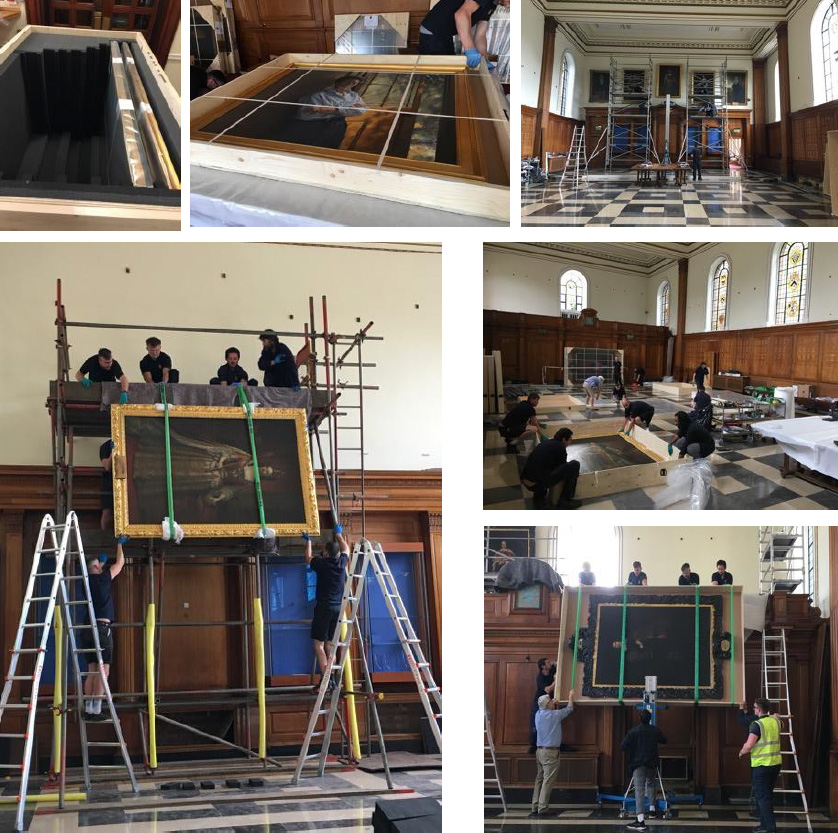
Works on paper:
 Over 200 framed works on paper were packed with layers of protection including low-tack glass tape, packed into travel frames, slotted crates or soft wrapped with furnisoft as appropriate.
Over 200 framed works on paper were packed with layers of protection including low-tack glass tape, packed into travel frames, slotted crates or soft wrapped with furnisoft as appropriate.
Textiles:
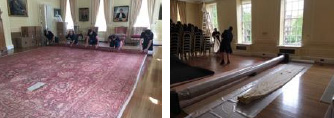 Carpets from the collections were rolled onto plastic tubes and sealed with polythene, and nearly 40 curtains were wrapped in polythene. All the textiles were taking for freezing prior to storage to ensure that there was no pest infestation in the fibres.
Carpets from the collections were rolled onto plastic tubes and sealed with polythene, and nearly 40 curtains were wrapped in polythene. All the textiles were taking for freezing prior to storage to ensure that there was no pest infestation in the fibres.
Sculpture and three-dimensional works:

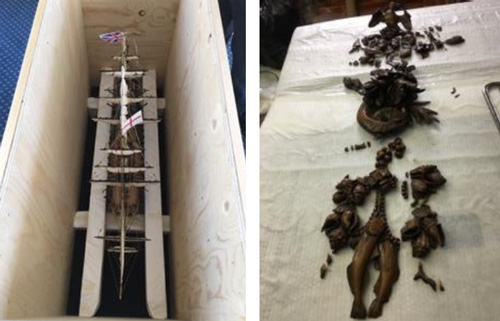 The rich diversity of the three-dimensional objects kept the project team on their toes. The art handlers packed marble and plaster busts, and the HMS Victory model that had been on display in rooms, the gallery and on staircases into specially designed purpose-built cases. Several subject-specialists were brought in to remove and safely pack objects such as the Rysbrack marble sculpture of Pegasus and the delicate wood carving by Grenlin Gibbon.
The rich diversity of the three-dimensional objects kept the project team on their toes. The art handlers packed marble and plaster busts, and the HMS Victory model that had been on display in rooms, the gallery and on staircases into specially designed purpose-built cases. Several subject-specialists were brought in to remove and safely pack objects such as the Rysbrack marble sculpture of Pegasus and the delicate wood carving by Grenlin Gibbon.
Furniture:
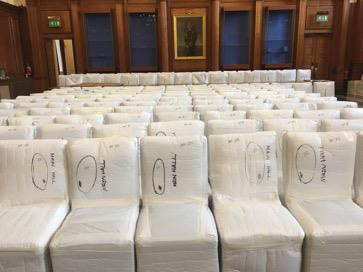 The project team wrapped and transported over 500 pieces of furniture from the Inner Temple, ranging from fine antique bookcases and long case clocks to leather dining chairs and side tables. Each piece was carefully wrapped in furnisoft with acid-free tissue and low-tack glass tape where necessary.
The project team wrapped and transported over 500 pieces of furniture from the Inner Temple, ranging from fine antique bookcases and long case clocks to leather dining chairs and side tables. Each piece was carefully wrapped in furnisoft with acid-free tissue and low-tack glass tape where necessary.
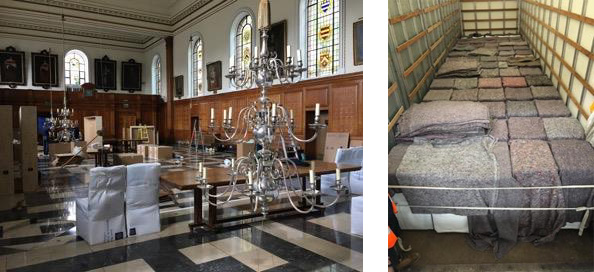
Catering equipment:
In addition to the art collections, some of the contents of the behind-the-scenes functions of the Inner Temple were also packed up for safe storage. These included contents from the catering department which included table linens and chairs covers, to cutlery, crockery, pans, glasses, vases, candlesticks and wine racks. In fact the whole myriad of contents that a large catering department requires for daily dining and entertaining functions.
Storage: As the project progressed the storage requirements from the Inner Temple project grew significantly because it grew increasingly clear that furniture could not be left stored on site during the building works-even in moth-balled rooms. Jamie Briggs was able to offer the Inner Temple art collections and Library a variety of storage options to suit the different needs of the collections-from containerised storage to designated storage rooms.
National Conservation Service: The most valuable art, furniture and library collections were taken to the National Conservation Service for storage. Located on the same ex-RAF base in Upper Heyford, the storage facilities offered here are located in old aircraft hangers and offer a greater degree of environmental control than heated storage-for when the collections require a slightly different storage environment. The Jamie Briggs team delivered everything to the site for safe receiving and storage for the duration of the two-year project.
Lessons Learned:
Access issues: There were significant access issues to the site with restrictions of vehicle access to the Inner Temple. Large items had to be moved on skates with teams of people, and smaller items needed to be trans-shipped using a smaller 3.5t vehicle that could get access to the Inner Temple site, with a larger truck parked outside in suspended parking bays-all of which needed to be booked well in advance.
Crating: Several suppliers were approached for the manufacture and supply of suitable crates for the project. Abrahams cases are a long established and experienced firm specialising in crates for art collections and were an asset to the project through quality, pricing and flexibility for supplying the crates. They were also based locally which meant no double handling of crates.
Specialist Equipment and Expertise: Inevitably for a project this complex and diverse a variety of expertise was required. Some of this existed on the Jamie Briggs team already, others had to be brought in specially for the project. This included project management, art handling, specific tool kits and working at height equipment and subject-specialist conservators.
Following a project de-brief, it was decided a designated project manager to manage operations and logistics from the office will be provided in future to ensure smooth communication, trucks, parking, correct ordering of kits and supplies, staffing and travel/accommodation bookings and so on.
The return of collections will have to be planned in great detail to ensure the smooth installation of the collections back into the new building at the end of the building project.
The Honourable Society of the Inner Temple. Library decant, March 2019.
Project Overview Library/Archive Move
The library move was a significant part of the Inner Temple project. The initial work to be carried out was to clear the Basement of the library from all books.
Phase 1 – Basement
At team of 10 technicians from Jamie Briggs were placed to remove and store all book collections from the Basement. Once cleared the team were to start decanting of the main library.
Phase 2 – Library
Using roller racking a further team of 10 started the decanting of the main library packing in chronological order the various collections of books. Working left to right through each panel of shelves, top to bottom removing and packing 2.5 kilometres of precious book. The technique adopted to decant the main library would prove invaluable as the different collection of books were being stored in 3 locations, a temporary library in Fleet Street – Fetter Lane, Restore – special climate control storage facility in Upper Heyford – Oxford and in the basement at the Inner Temple. Those in the Basement had to be kept in an accessible state for the students over the refurbishment period. In addition to the books, the team had to export wrap and remove antique reading tables with reading lights, large oak tables, and chairs. The most effective way of decanting the furniture was by the removal of one of the windows to one end of the library via an external elevator to the side of the building. Every single movement of the entire contents of the library was referenced for inventory.
In 18 months the careful, methodical approach to the decant operation will come to the fore as all the books from all three locations will be replaced in their identical position, as referenced. In itself, it is a skilled process that requires the whole team working in unison with the greatest attention to detail. The whole project for the Library was completed over a 3 month period.














